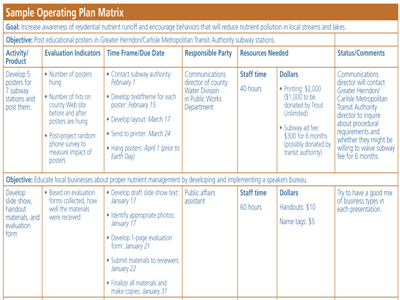
|
Watershed Academy Web
Getting in Step: a Guide to Effective Outreach in Your Watershed
Watershed Academy Web
Getting in Step: a Guide to Effective Outreach in Your Watershed

|
In Part I you learned about the six steps of outreach and how to develop an outreach campaign plan. In Part II you'll learn some tricks of the trade to get you started on implementing the campaign you've planned.
From the outreach plan you developed in Part 1, you need to create a "to do" list in tabular format to figure out who's going to do what and by when, and to identify how much each task will cost. This table will become your day-to-day operating plan. Don't worry if there are holes in the table. You can beef up staff numbers by forming partnerships with other local agencies and organizations, and you can increase your budget by applying for grants or obtaining in-kind services. Tips are provided below to help you secure additional resources-both people and dollars. The key is to outline your operating plan based on what will achieve the objectives in the overall campaign plan you developed in Part 1. When you first create the table, focus on the activities and the time frame needed. If you determine that you can't complete the activities because of lack of funding or staff, you can make choices to scale back certain activities or phase in activities over time.
Once you've started filling in your operating plan with your calendar, you'll know why determining available resources and support to implement your campaign is the next critical step. You'll need three basic things to launch your campaign: staff, technical support, and financial support. Do you have the resources to conduct the background research to develop your plan? Do you have the resources to implement your plan? If your plan is larger than your budget, think about ways you can alter the plan or consider looking outside your organization for support. In addition, consider forming partnerships to pool funding and expand potential impact. Partnerships can often help sustain an effort after initial seed money has been spent. Look for partners that have some common goal with your organization.
Weaving partners through the process of watershed improvement efforts strengthens the end result by gathering new ideas and input, and increasing public buy-in of the problems and their solutions. Partnerships also help identify and eliminate redundant efforts. For example, one watershed organization may be interested in developing a volunteer monitoring program, but is unaware that one of the local county parks department is also developing a similar program. Researching and identifying partners could help avoid reinventing the wheel-wasting time and money.
In a world where budgets come and go, resources for watershed improvement efforts such as fencing cows out of streams are limited. Resources like technical assistance, mapping abilities, access to private land, funding, etc. are always strained, but working with partners who can provide some of those resources will get your effort closer to its goals more efficiently.